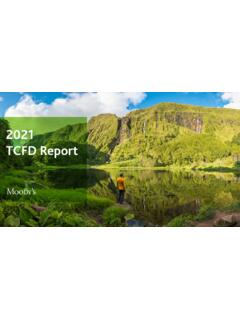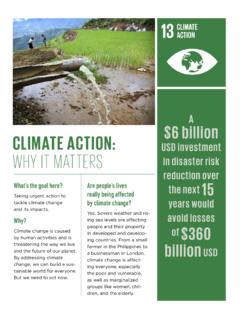Transcription of Green Infrastructure Investment Opportunities
1 Philippines GIIO Report climate Bonds Initiative 1 Green Infrastructure Investment Opportunities PHILIPPINES 2020 REPORTS upported by the ASEAN Catalytic Green Finance Facility, the Asian Development Bank and the Securities and Exchange Commission PhilippinesPhilippines GIIO Report climate Bonds Initiative 2 This report has been prepared to help meet the growing demand for Green Investment Opportunities in the Philippines and to support the country s transition to a low carbon economy. It aims to facilitate greater engagement on this topic between project owners and developers, and institutional investors. Green Infrastructure and corresponding Green finance instruments are explored in the report, with sector-by-sector Investment options presented. The report is intended for a wide range of stakeholders, including domestic investors, offshore pension funds and asset managers, potential issuers, Infrastructure owners and developers, as well as relevant government ministries.
2 In developing this report, the climate Bonds Initiative (CBI) consulted with key Government bodies, industry, the financial sector, peak bodies, NGOs and think Table of contentsSEC Foreword ADB Foreword Green Infrastructure : an opportunity for growth Snapshot: Macroeconomic outlook Snapshot: Infrastructure spending Snapshot: climate policy Green finance trends and Opportunities Global demand for Green is growing Green finance is growing in the Philippines Snapshot: The Philippines Green Bond Market Brown to Green transition in the PhilippinesGreen Infrastructure Investment Opportunities Renewable energy Low carbon transport Sustainable water management Sustainable waste management Other Green Opportunities Measures for growing Green infrastructureAnnexes Annex I: Green debt instruments Annex II: Green equity instruments Annex III: Credit enhancement mechanisms Annex IV: Risk transfer instruments Annex V: Green standards applicable in the Philippines Annex VI: Sample Green Pipeline Endnotestanks in partnership with the Securities and Exchange Commission (SEC) of the Philippines and the Asian Development Bank (ADB).
3 We would like to thank these partners along with the other organisations that contributed to the report: The Philippines Department of Finance, the Public-Private Partnership Center of the Philippines; National Economic and Development Authority (NEDA), Development Bank of the Philippines, BDO Unibank, Rizal Commercial Banking Corporation (RCBC), Thomas Lloyd Group, AC Energy, and BioPower Group. CBI also acknowledges the contributions made from members of the ADB Southeast Asia Innovation Hub and ASEAN Catalytic Green Finance Facility (ACGF) teams, including Joven Balbosa, Advisor, ADB Southeast Asia Department; Anouj Mehta, Unit Head, Green and Innovative Finance and the ACGF; Camille Bautista-Laguda (consultant, ACGF); Lianne De La Paz (consultant, ACGF), and Marina L pez Andrich (consultant ACGF).
4 climate Bonds Initiative The climate Bonds Initiative is an international investor-focused not-for-profit organisation working to mobilise the USD100tn bond market for climate change solutions. It promotes Investment in projects and assets needed for a rapid transition to a low carbon and climate resilient economy. The mission is to help drive down the cost of capital for large-scale climate and Infrastructure projects and to support governments seeking increased access to capital markets to meet climate and greenhouse gas (GHG) emission reduction goals. CBI carries out market analysis, policy research, market development; advises governments and regulators; and administers a global Green bond standard and certification scheme. CBI screens Green finance instruments against its climate Bonds Taxonomy to determine alignment and uses sector specific criteria for certification.
5 A simplified version of the climate Bonds Taxonomy is on page 59. More information on the climate Bonds Standard and Certification Scheme can be found on page 6 7 910 10 11 12 20 24 25 28 31 35 3839 4040 43 44 46 47 4954 Supported by European climate FoundationGreen Infrastructure Investment Opportunities VIETNAM 2019 REPORTS upported by European climate FoundationGreen Infrastructure Investment Opportunities INDONESIA UPDATE REPORTS ponsorsGreen Infrastructure Investment Opportunities AUSTRALIA 2019 Green Infrastructure Investment Opportunities (GIIO) Report Series Green Infrastructure presents a huge Investment opportunity globally, with an estimated USD100tn worth of climate compatible Infrastructure required from now to 2030, in order to meet Paris Agreement emissions reduction targets.
6 However, there remains a lack of identifiable, Investment -ready and bankable projects. There is also a lack of understanding of what types of assets and projects qualify for Green financing. In response to this challenge, CBI is developing a series of reports that aim to identify and demonstrate Green Infrastructure Investment Opportunities around the world. By so doing, it aims to raise awareness of what is Green and where to invest, as well as to promote Green bond issuance as a tool to finance Green Infrastructure . The report series commenced with the GIIO Indonesia report, launched in May 2018, followed by five other reports Exchange Rate September 30, 2020 1 USD = PHP 1 PHP = USDThis report highlights Green Infrastructure Investment Opportunities in the Philippines the latest being the GIIO Vietnam report, launched in April 2020.
7 Future GIIO reports will include further exploration of Opportunities in Asia-Pacific as well as in Latin Philippines GIIO Report climate Bonds Initiative 3As an archipelago in South East Asia situated on both the Typhoon Belt and Pacific Ring of Fire, the Philippines has long been exposed to environmental challenges. In fact, the country is considered among the most vulnerable to the effects of climate change the nation s 100+ million people which are spread across more than 7,000 islands, regularly face powerful and increasingly more frequent typhoons, earthquakes and volcanic eruptions. In more recent years, the country also had to deal with rising sea levels, and periods of droughts and floods caused by the El Nino and La Nina weather phenomena. Armed with first-hand experience in dealing with the overwhelming impact of climate change on the economy, Philippine authorities worked toward establishing a supportive enabling environment for the development of a sustainable financial market.
8 Among the measures taken by the Philippine Securities and Exchange Commission (SEC), in conjunction with fellow ASEAN regulators, was the adoption of the ASEAN Green Bond Standards (GBS), ASEAN Social Bond Standards (SBS) and the ASEAN Sustainability Bond Standards (SUS). These ASEAN Standards were developed by the ASEAN Capital Markets Forum (ACMF) and were intentionally aligned with the International Capital Market Association s Green , Social and Sustainability Bond Principles, as well as the climate Bond Initiative s (CBI) criteria. The ASEAN Standards were intended to provide clear guidance for issuers as well as a measure of assurance to investors that bonds carrying the ASEAN Green and Sustainability labels adhere to international best practice. Notably, the ASEAN GBS goes a step further than the ICMA Green Bond Principles by expressly prohibiting fossil fuel power generation-related projects.
9 Since the adoption of the ASEAN Standards, we have seen the rapid growth of the Philippine Green bond market led mainly by the private sector. To date, total Philippine sustainable bond issuances stands at US$ billion equivalent both on and offshore 90% of which have been issued by Philippine banks, renewable energy, Infrastructure and real estate companies. This active and primary role of private sector Green bond issuers distinguishes the Philippines from other nascent Green markets, where sovereign borrowers have played a more prominent first mover role. Indeed, in 2019, of the total loan portfolio of the Philippine banking system went to finance Green and social projects that were in line with the Sustainable Development Goals of the United currencies in which our firms raised funds have been diverse, from Philippine Pesos, to US Dollars, and even a Swiss Franc placement that last transaction, by one of the top three Philippine banks, resulted in a negative yield.
10 This diversity has been crucial for it exposed our issuers to a wide and diverse range of investors and their specific concerns and expectations. This diversity raising bonds locally, in the region and in Europe, and in multiple currencies provides a strong foundation for additional issuance and Green finance is relatively new in the Philippines, the first movers in our market have been instrumental in introducing the concept to our domestic investor base and making other local firms aware of the potential for Green finance. Importantly, most Philippine Green and sustainability bonds (roughly US$ billion worth) have carried the ASEAN Green or Sustainability label, with all ASEAN labeled bonds also carrying second party opinions from noted providers, such as Sustainalytics and Vigeo-Eiris.















